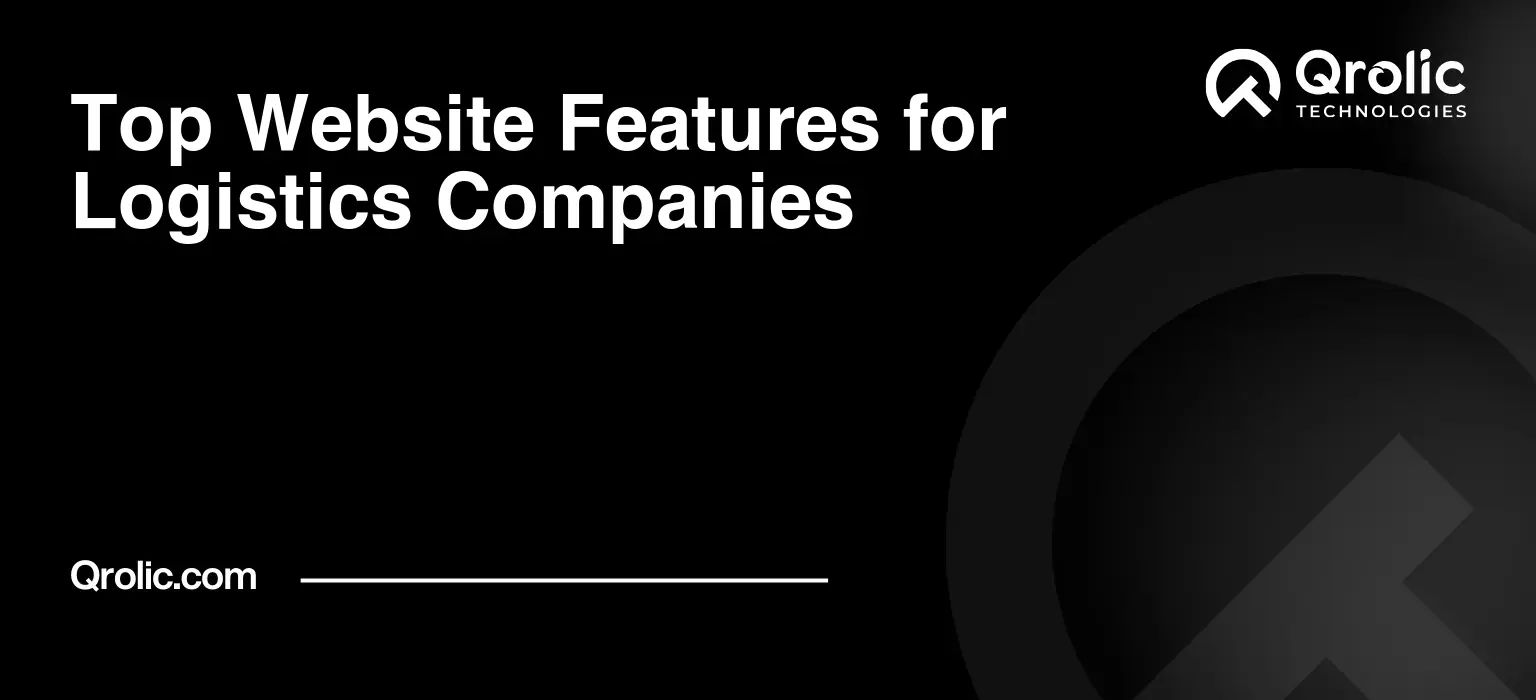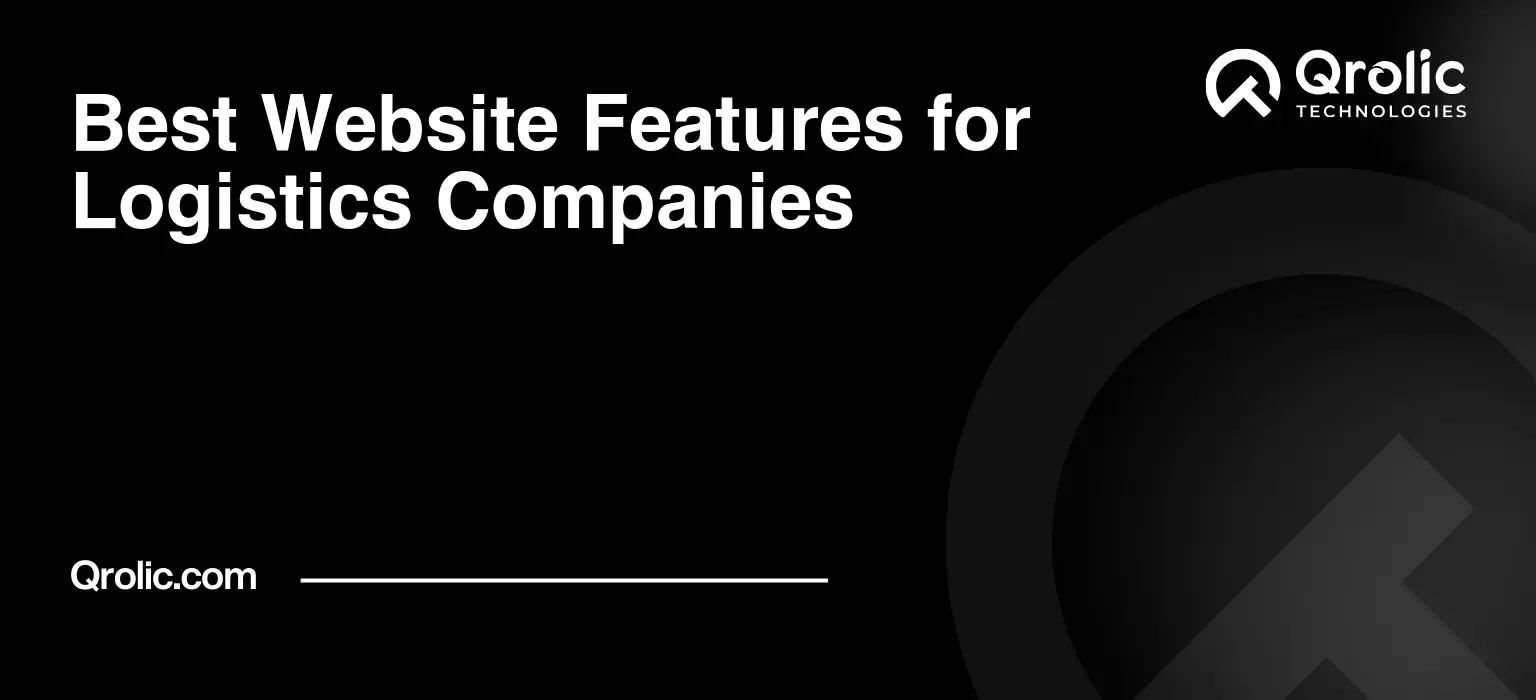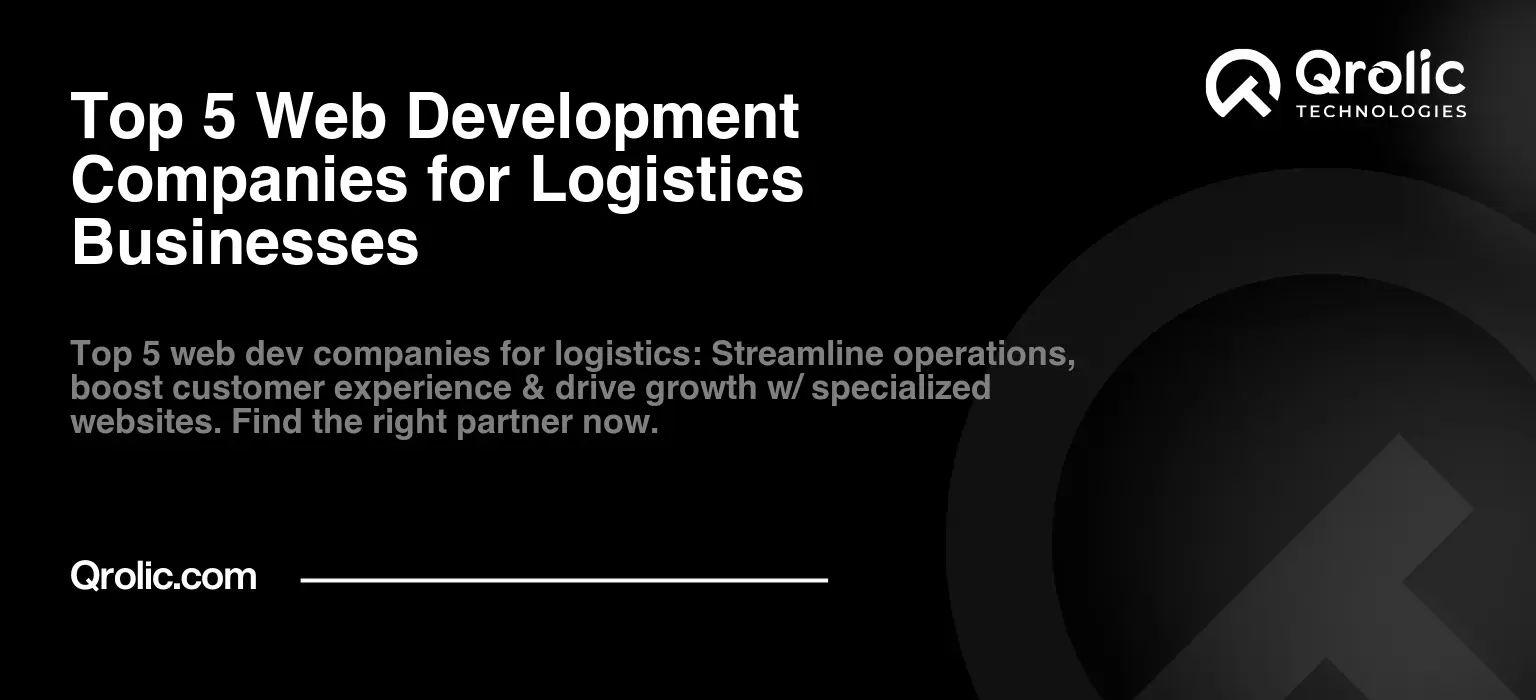Quick Summary:
- Your website is essential for logistics growth.
- Include core features like tracking and quotes.
- Add advanced tools for better customer service.
- Optimize your site to be easily found online.
Table of Contents
- Why Your Logistics Website Needs to Be More Than Just a Business Card
- The Ever-Changing Landscape of Logistics and the Web
- The Cost of Ignoring Your Website’s Potential
- Core Features Every Logistics Website MUST Have
- 1. User-Friendly Navigation: The GPS for Your Website
- 2. Comprehensive Service Information: Showcasing Your Expertise
- 3. Freight Request (Quote Request) Functionality: Making It Easy to Do Business
- 4. Shipment Tracking: Real-Time Visibility, Real-Time Peace of Mind
- 5. Contact Information and Support: Being Accessible and Responsive
- 6. Blog and News Section: Your Platform for Industry Leadership
- Advanced Features to Take Your Logistics Website to the Next Level
- 7. Integration with Transportation Management System (TMS): Streamlining Operations
- 8. Customer Portal: Personalized Service at Their Fingertips
- 9. Interactive Maps and Route Planning: Visualizing the Journey
- 10. Multi-Language Support: Expanding Your Global Reach
- 11. AI-Powered Chatbots: 24/7 Customer Support
- Optimizing Your Logistics Website for Search Engines (SEO)
- 12. Keyword Research: Understanding What Your Clients Are Searching For
- 13. On-Page Optimization: Making Your Website Search Engine Friendly
- 14. Off-Page Optimization: Building Authority and Credibility
- 15. Mobile Optimization: Catering to the Mobile-First World
- Qrolic Technologies: Your Partner in Building a Winning Logistics Website
- How Qrolic Technologies Can Help
- Why Choose Qrolic Technologies?
- Conclusion: Investing in Your Website is Investing in Your Future
Why Your Logistics Website Needs to Be More Than Just a Business Card
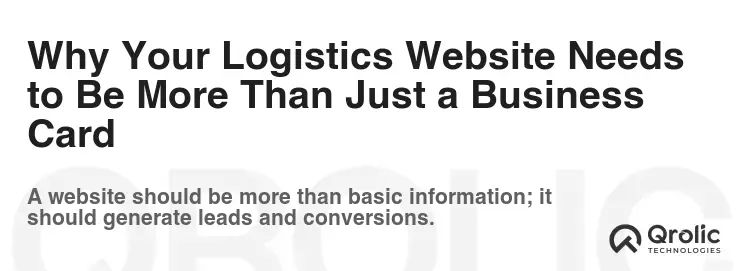
In today’s fast-paced, always-on world, a website isn’t just an online brochure; it’s your digital storefront, your 24/7 salesperson, and often, the first impression you make on potential clients. For logistics companies, this is especially true. Your website can be the difference between winning a lucrative contract and watching a competitor haul it away. Think of it like this: are you driving a rusty old truck or a sleek, modern rig? Your website reflects that. This is why focusing on key website features is crucial for success.
The Ever-Changing Landscape of Logistics and the Web
The logistics industry is constantly evolving. Technology, customer expectations, and global events are reshaping the playing field. Your website needs to keep pace, offering not just information, but solutions. It needs to be intuitive, informative, and, frankly, a pleasure to use. A clunky, outdated website screams inefficiency and lack of tech-savviness, traits that no one wants in their logistics partner.
- Meeting Evolving Customer Expectations: Clients now expect instant gratification, real-time updates, and seamless communication. Your website is the platform to deliver that.
- Staying Ahead of the Competition: In a competitive market, a well-designed, feature-rich website sets you apart, showcasing your capabilities and commitment to excellence.
- Adapting to Technological Advancements: Embrace technology! Integrate features like AI-powered chatbots and real-time tracking to enhance the user experience.
The Cost of Ignoring Your Website’s Potential
What happens if you neglect your website? The consequences can be severe:
- Lost Leads and Missed Opportunities: A poorly designed website will turn potential clients away before they even reach out.
- Damage to Your Brand Reputation: An outdated website suggests your company is also outdated.
- Decreased Customer Satisfaction: Frustrated users are unhappy customers. They’ll take their business elsewhere.
- Lower Search Engine Rankings: Without proper SEO, your website will be buried in search results, making it invisible to potential clients.
Core Features Every Logistics Website MUST Have
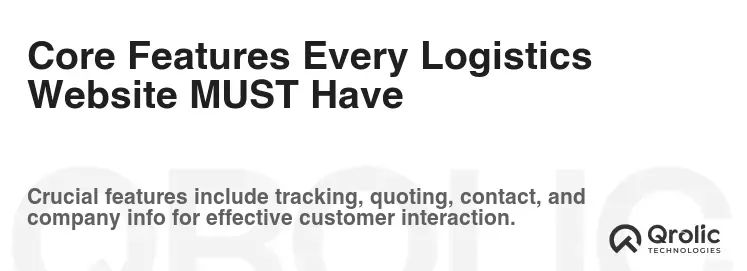
These are the non-negotiable features that form the foundation of a successful logistics website. Think of them as the engine and wheels of your operation.
1. User-Friendly Navigation: The GPS for Your Website
Imagine a road without signs. Frustrating, right? That’s what a website without intuitive navigation is like. Your website needs to be easy to navigate, allowing visitors to find what they need quickly and efficiently.
- Clear and Concise Menu Structure: Use simple, descriptive labels for your menu items. Avoid jargon and internal terms.
- Logical Information Architecture: Organize your content in a way that makes sense to your users, not just to you.
- Prominent Search Bar: Make it easy for visitors to search for specific information on your website.
- Breadcrumb Navigation: Help users understand where they are on your website and easily navigate back to previous pages.
- Mobile-Responsive Design: Ensure your website looks and functions flawlessly on all devices, from desktops to smartphones.
Example: Instead of labeling a menu item “Supply Chain Solutions,” use “Our Services” and then break down the specific services on that page.
Benefit: Improved user experience, increased engagement, and higher conversion rates.
2. Comprehensive Service Information: Showcasing Your Expertise
Your website is your opportunity to showcase your expertise and the services you offer. Be clear, concise, and compelling. Think of it as your elevator pitch, but with visuals.
- Detailed Descriptions of Each Service: Explain what each service entails, the benefits it offers, and the industries it serves.
- Case Studies and Success Stories: Showcase your successes with real-world examples. Quantify the results you’ve achieved for your clients.
- High-Quality Images and Videos: Use visuals to illustrate your services and expertise. Show your trucks, warehouses, and team in action.
- Client Testimonials: Let your satisfied clients speak for you. Positive testimonials build trust and credibility.
- Certifications and Accreditations: Highlight your industry certifications and accreditations to demonstrate your commitment to quality and compliance.
Example: Instead of just listing “Freight Forwarding,” explain the process, the types of freight you handle, and the regions you serve. Include a case study of a successful freight forwarding project.
Benefit: Increased credibility, higher conversion rates, and a stronger brand reputation.
3. Freight Request (Quote Request) Functionality: Making It Easy to Do Business
Make it as easy as possible for potential clients to request a quote. A streamlined quote request process can significantly increase your lead generation. Think of it as rolling out the red carpet.
- Easy-to-Find Quote Request Form: Place the quote request form prominently on your website, especially on service pages.
- Clear and Concise Form Fields: Keep the form short and focused, asking only for essential information.
- Automated Response System: Send an immediate confirmation email to acknowledge receipt of the request.
- Integration with Your CRM: Automatically transfer quote requests to your CRM system for efficient follow-up.
- Mobile-Friendly Form: Ensure the quote request form is easy to complete on mobile devices.
Example: Include fields for origin, destination, dimensions, weight, and desired delivery date. Offer options for different service levels (e.g., express, standard).
Benefit: Increased lead generation, improved efficiency, and better customer service.
4. Shipment Tracking: Real-Time Visibility, Real-Time Peace of Mind
In the age of instant gratification, shipment tracking is no longer a luxury; it’s a necessity. Clients want to know where their goods are at all times. Think of it as providing a window into your operations.
- Real-Time Tracking Updates: Provide up-to-the-minute information on the location and status of shipments.
- Easy-to-Use Tracking Interface: Make it easy for clients to enter their tracking number and access shipment information.
- Proactive Notifications: Send automated email or SMS notifications to clients when their shipment reaches key milestones.
- Integration with Your Tracking System: Seamlessly integrate your website with your internal tracking system.
- Mobile App (Optional): Consider developing a mobile app for even more convenient tracking.
Example: Allow clients to view the current location of their shipment on a map, along with estimated delivery time.
Benefit: Increased customer satisfaction, reduced customer service inquiries, and a competitive advantage.
5. Contact Information and Support: Being Accessible and Responsive
Make it easy for clients to contact you and get the support they need. Think of it as opening the lines of communication.
- Prominent Contact Information: Display your phone number, email address, and physical address prominently on your website.
- Contact Form: Provide a contact form for inquiries and feedback.
- Live Chat Support: Offer live chat support to answer questions in real-time.
- FAQ Section: Address frequently asked questions to reduce the number of support inquiries.
- Social Media Links: Include links to your social media profiles to facilitate engagement.
Example: Create a dedicated “Contact Us” page with a map showing your office locations.
Benefit: Improved customer service, increased customer loyalty, and a stronger brand reputation.
6. Blog and News Section: Your Platform for Industry Leadership
A blog and news section is a powerful tool for showcasing your expertise, sharing industry insights, and attracting new clients. Think of it as your opportunity to establish yourself as a thought leader.
- Regularly Updated Content: Post new articles and news items on a regular basis.
- Informative and Engaging Content: Focus on topics that are relevant to your target audience.
- SEO-Optimized Content: Use keywords and phrases that your target audience is searching for.
- Shareable Content: Make it easy for readers to share your content on social media.
- Variety of Content Formats: Experiment with different content formats, such as blog posts, articles, infographics, and videos.
Example: Write about topics like “The Impact of Technology on the Logistics Industry,” “Tips for Optimizing Your Supply Chain,” or “The Latest Trends in Freight Transportation.”
Benefit: Increased website traffic, improved search engine rankings, and a stronger brand reputation.
Advanced Features to Take Your Logistics Website to the Next Level
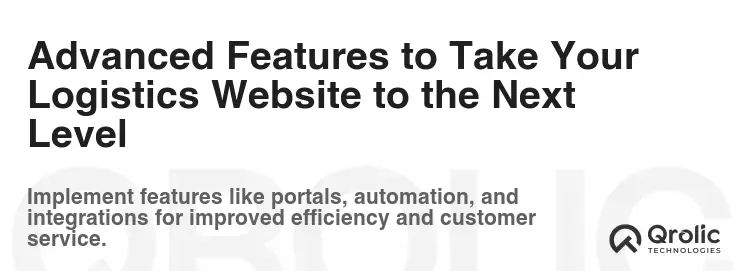
Once you have the core features in place, consider adding these advanced features to further enhance your website and provide a superior user experience. Think of them as the upgrades that make your operation truly exceptional.
7. Integration with Transportation Management System (TMS): Streamlining Operations
Integrating your website with your TMS can streamline your operations and provide clients with even more real-time visibility. Think of it as connecting the dots.
- Automated Data Transfer: Automatically transfer data between your website and your TMS, such as shipment information, rates, and invoices.
- Real-Time Rate Quotes: Provide clients with real-time rate quotes based on their specific requirements.
- Online Booking and Scheduling: Allow clients to book and schedule shipments online.
- Automated Reporting: Generate automated reports on key performance indicators (KPIs).
- Improved Efficiency: Streamline your operations and reduce manual data entry.
Example: Clients can enter their shipment details on your website and receive an instant rate quote based on your TMS data.
Benefit: Increased efficiency, improved accuracy, and better customer service.
8. Customer Portal: Personalized Service at Their Fingertips
A customer portal provides clients with a secure, personalized area where they can manage their account, track shipments, and access important documents. Think of it as giving them their own control panel.
- Secure Login: Provide clients with a secure login to access their personalized portal.
- Shipment Tracking: Allow clients to track their shipments in real-time.
- Order History: Provide clients with a complete history of their past orders.
- Document Management: Allow clients to access and download important documents, such as invoices and bills of lading.
- Account Management: Allow clients to update their contact information and manage their account settings.
Example: Clients can log in to their portal to view the status of all their current shipments, download invoices, and update their billing address.
Benefit: Increased customer satisfaction, improved customer loyalty, and reduced customer service inquiries.
9. Interactive Maps and Route Planning: Visualizing the Journey
Interactive maps and route planning tools can help clients visualize the journey of their shipments and understand the complexities of logistics. Think of it as bringing the logistics process to life.
- Real-Time Shipment Tracking on a Map: Show the current location of shipments on a map in real-time.
- Route Optimization Tools: Provide clients with tools to optimize their shipping routes.
- Distance and Time Calculation: Calculate the distance and estimated travel time between two points.
- Geofencing: Set up geofences to track shipments as they enter or exit specific areas.
- Integration with Mapping APIs: Integrate with mapping APIs, such as Google Maps or Bing Maps.
Example: Clients can enter the origin and destination of their shipment and view the optimal route on a map, along with the estimated travel time.
Benefit: Improved transparency, increased customer engagement, and better understanding of the logistics process.
10. Multi-Language Support: Expanding Your Global Reach
If you serve international clients, it’s essential to offer multi-language support on your website. Think of it as speaking their language.
- Professional Translations: Use professional translators to ensure accurate and culturally appropriate translations.
- Easy Language Switching: Make it easy for visitors to switch between languages.
- Support for Multiple Currencies: Display prices and rates in multiple currencies.
- Localized Content: Adapt your content to the specific needs and preferences of each target market.
- Improved User Experience: Provide a better user experience for international clients.
Example: Offer your website in English, Spanish, French, and Mandarin Chinese.
Benefit: Increased international reach, improved customer satisfaction, and a stronger global brand reputation.
11. AI-Powered Chatbots: 24/7 Customer Support
AI-powered chatbots can provide instant answers to common questions, freeing up your customer service team to focus on more complex issues. Think of it as having a virtual assistant.
- Natural Language Processing (NLP): Use NLP to understand and respond to user queries in a natural and conversational way.
- 24/7 Availability: Provide customer support 24 hours a day, 7 days a week.
- Automated Answers to FAQs: Automate answers to frequently asked questions.
- Lead Generation: Qualify leads and collect contact information.
- Integration with CRM: Integrate with your CRM to track chatbot interactions and generate reports.
Example: A chatbot can answer questions about shipping rates, tracking numbers, and service offerings.
Benefit: Improved customer service, increased efficiency, and reduced customer service costs.
Optimizing Your Logistics Website for Search Engines (SEO)
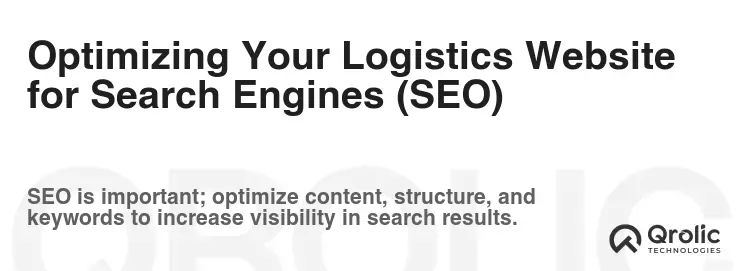
Having a great website is only half the battle. You also need to make sure that potential clients can find it on search engines like Google. This is where SEO comes in. Think of it as putting a giant sign on your website that says, “We’re here, and we’re the best!”
12. Keyword Research: Understanding What Your Clients Are Searching For
The first step in SEO is to understand what keywords and phrases your target audience is searching for. Use keyword research tools like Google Keyword Planner, SEMrush, and Ahrefs to identify relevant keywords.
- Identify Target Keywords: Identify keywords that are relevant to your services and target audience.
- Analyze Keyword Competition: Analyze the competition for each keyword to determine its difficulty.
- Focus on Long-Tail Keywords: Focus on long-tail keywords (longer, more specific phrases) to target niche audiences.
- Use Keywords Naturally: Use keywords naturally throughout your website content.
- Monitor Keyword Performance: Monitor the performance of your keywords and adjust your strategy as needed.
Example: Instead of just targeting the keyword “logistics,” target long-tail keywords like “affordable freight shipping from Chicago to Los Angeles.”
Benefit: Improved search engine rankings, increased website traffic, and higher conversion rates.
13. On-Page Optimization: Making Your Website Search Engine Friendly
On-page optimization involves optimizing the content and structure of your website to make it more search engine friendly.
- Optimize Title Tags and Meta Descriptions: Write compelling title tags and meta descriptions that accurately describe the content of each page.
- Use Header Tags (H1-H6): Use header tags to structure your content and make it easier for search engines to understand.
- Optimize Images: Use descriptive alt tags for your images.
- Create High-Quality Content: Create high-quality, informative, and engaging content that is relevant to your target audience.
- Internal Linking: Link to other relevant pages on your website.
Example: Use the keyword “freight shipping” in the title tag, meta description, and header tags of your freight shipping service page.
Benefit: Improved search engine rankings, increased website traffic, and a better user experience.
14. Off-Page Optimization: Building Authority and Credibility
Off-page optimization involves building authority and credibility for your website through link building and other strategies.
- Link Building: Earn high-quality backlinks from other websites.
- Social Media Marketing: Promote your website and content on social media.
- Online Directory Listings: List your website in relevant online directories.
- Guest Blogging: Write guest posts for other websites in your industry.
- Reputation Management: Monitor your online reputation and respond to reviews and feedback.
Example: Reach out to industry publications and offer to write a guest post about a relevant topic.
Benefit: Improved search engine rankings, increased website traffic, and a stronger brand reputation.
15. Mobile Optimization: Catering to the Mobile-First World
With the majority of internet users accessing the web on mobile devices, it’s crucial to ensure that your website is mobile-optimized.
- Responsive Design: Use a responsive design that adapts to different screen sizes.
- Fast Loading Speed: Optimize your website for fast loading speed on mobile devices.
- Touch-Friendly Navigation: Design your navigation to be easy to use on touchscreens.
- Mobile-Friendly Forms: Ensure your forms are easy to complete on mobile devices.
- Test Your Website on Mobile Devices: Regularly test your website on different mobile devices.
Example: Use a mobile-friendly theme or template and optimize your images for mobile devices.
Benefit: Improved user experience, increased website traffic, and higher conversion rates.
Qrolic Technologies: Your Partner in Building a Winning Logistics Website
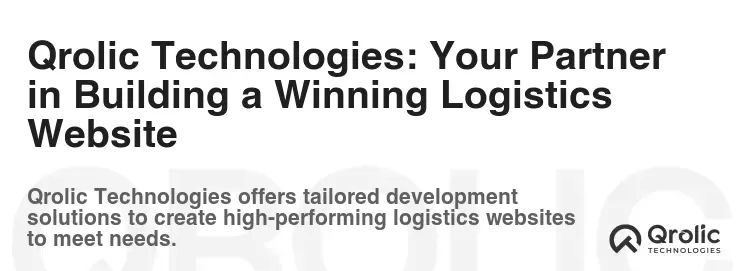
At Qrolic Technologies (https://qrolic.com/), we understand the unique challenges and opportunities that logistics companies face in the digital age. We specialize in building custom websites and software solutions that are tailored to the specific needs of the logistics industry.
How Qrolic Technologies Can Help
- Website Design and Development: We create visually appealing and user-friendly websites that are optimized for search engines and mobile devices.
- Custom Software Development: We develop custom software solutions to streamline your operations and improve your efficiency.
- Integration Services: We integrate your website with your existing systems, such as your TMS and CRM.
- SEO and Digital Marketing: We help you improve your search engine rankings and attract more leads.
- Ongoing Support and Maintenance: We provide ongoing support and maintenance to ensure that your website is always running smoothly.
Why Choose Qrolic Technologies?
- Industry Expertise: We have a deep understanding of the logistics industry.
- Custom Solutions: We create custom solutions that are tailored to your specific needs.
- Experienced Team: We have a team of experienced developers, designers, and marketers.
- Results-Driven Approach: We are focused on delivering results that help you grow your business.
- Competitive Pricing: We offer competitive pricing and flexible payment options.
Contact us today to learn more about how Qrolic Technologies can help you build a winning logistics website!
Conclusion: Investing in Your Website is Investing in Your Future
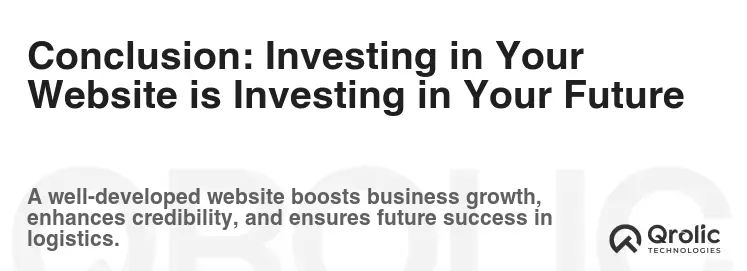
In conclusion, your website is a critical asset for your logistics company. By investing in the right features and optimizing your website for search engines, you can attract more leads, improve customer satisfaction, and grow your business. Don’t think of your website as an expense; think of it as an investment in your future. A well-designed, feature-rich website is the key to unlocking success in the competitive logistics industry. So, take the time to assess your current website, identify areas for improvement, and implement the strategies outlined in this article. Your bottom line will thank you for it. Remember, in today’s digital world, your website is often the first impression you make. Make it count!
